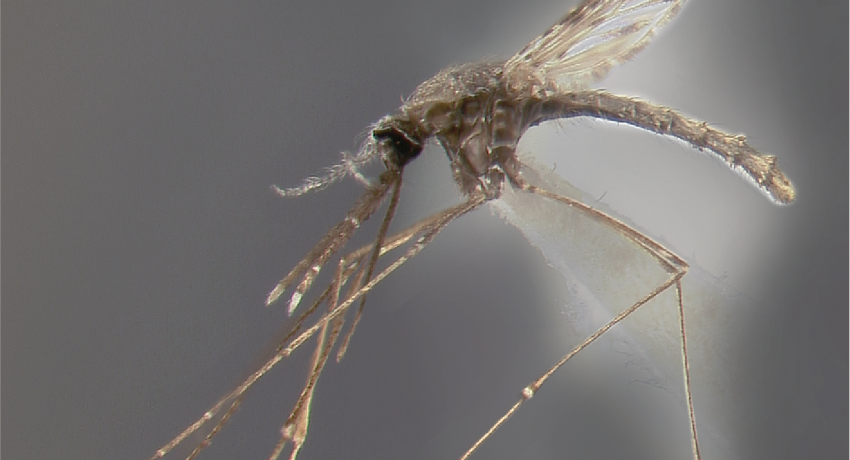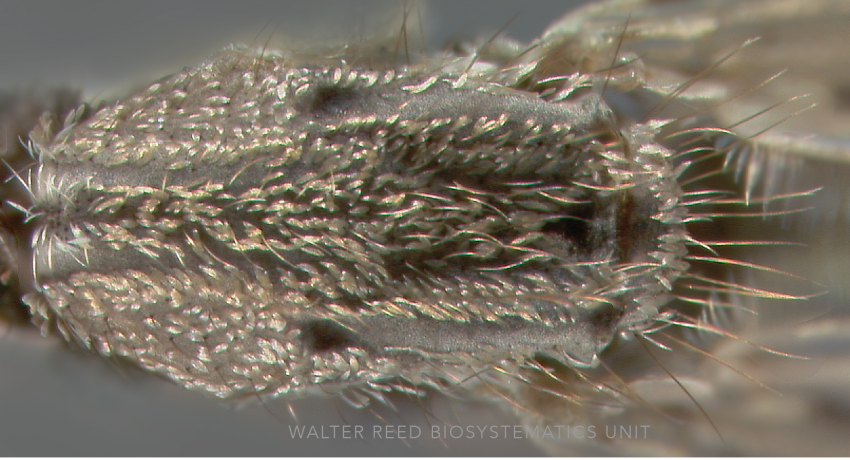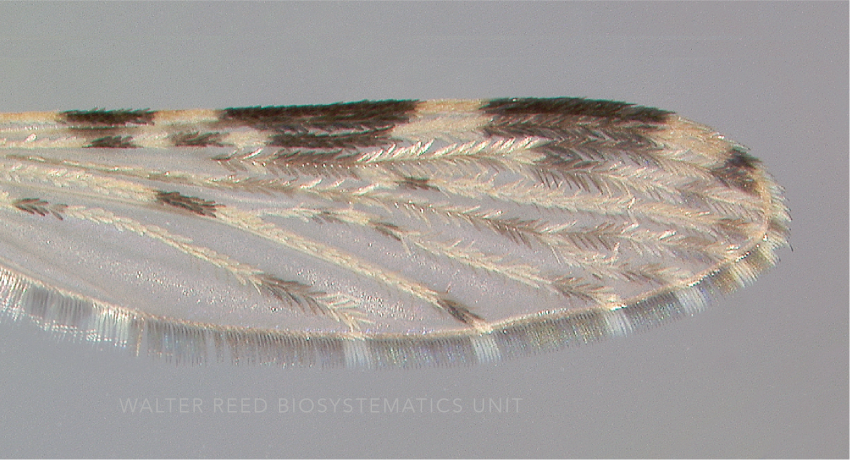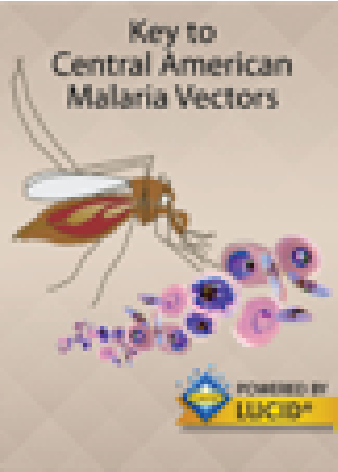NEARCTIC & NEOTROPICAL REGIONS
Etymology: not stated [white hand (L); probably refers to white Ta-III5]
Anopheles albimanus is the nomiotypical species of the Albimanus Section, and the sole representative of the Albimanus Series. Six species are currently placed in synonymy with An. albimanus, including An. cubensis Agramonte, An. albipes Theobald, An. tarsimaculata Goeldi, An. gorgasi Dyar & Knab, An. bisignatus Hoffman, and An. trisignatus Hoffman.
Given its primary malaria vector status, Anopheles albimanus has been closely studied, but the presence of cryptic taxa has not been suggested. However, a novel species—An. albimanus B pending formal description—was recently detected in our laboratory using DNA approaches. This cryptic species was collected allopatrically in Guayas, Ecuador, and later detected in archive samples collected in Pinchincha and Esmeraldas, Ecuador, and again in biosurveillance studies in Tumbes, Peru, suggesting it is fairly widespread in the southern parts of its range. Populations from the type locality in the Dominican Republic need to be genetically assessed to define An. albimanus s.s., before the true composition of the Albimanus Complex can be defined.
Type locality: St. Domingo Institute [Dominican Republic]
Type depository: Naturhistorisches Museum, Vienna, Austria (NMW)
DIAGNOSTIC CHARACTERS (Click photos to view; mouse over and click large photo to zoom in.)
ADULT (illustrated): Legs: Ta-III3,4 entirely white; Ta-III5 with a basal dark band; Ta-I5 usually all dark. Head: Palpomere MPlp4 with dark or yellow to golden-brown scales on mediolateral surface, scales never white or cream-colored. Wing: Accessory sector pale spot about 0.4 from wing base, conspicuously closer to sector pale than to subcostal pale spot. Abdomen: II-Te without dark posterolateral scale tufts.
LARVA (not illustrated): Head: Seta 2-C aciculate; seta 4-C moderately long to long, usually extending to anterior margin of head. Thorax: Seta 1-P plumose, with filiform branches; setae 1,2-P on large common tubercle. Abdominal segments: Seta 1 palmate leaflets smooth-sided; seta 13-I–IV moderately large to large.
TAXONOMIC KEYS
Roth 1944
Pelaez 1945
Carpenter & LaCasse 1955
Dodge 1966
Faran 1980
Darsie & Ward 2005
Becker et al. 2010
Beltrán-Aguilar et al. 2011
Sallum, et al. 2020
![]()
Anopheles – Central America -– Adult
![]()
Anopheles – Central America – Larva
![]()
WRBU - Genera - Global - Adult
![]()
WRBU - Genera - Global - Larva
Exemplar DNA sequences
An. albimanus COI: FJ516463-553, whole genome GCA_000349125.
BIONOMICS
Immatures
Preferred oviposition sites for An. albimanus s.l. are typically permanent, open-sunlit ground pools with muddy substrata, abundant algal vegetation, particularly blue-green algae, and clear water. These can include fresh or brackish water ground pools, lakes and swamps, drainage ditches, rice fields, and occasionally in water-filled animal hoof prints after heavy rains.
Adults
Adult An. albimanus s.l. are typically found in humid lowlands (<500m a.s.l.); populations peak in the dry season, but they are present all year round. Biting patterns vary across its range. Females rest indoors in high number within houses in Mexico, yet in other parts of its range, females will feed indoors but return to the forest to rest. Horse-baited traps are the standard method for assessing adult densities of An. albimanus s.l. in Latin America. In Mexico, females are readily attracted to human-, horse- and donkey-baited traps, with highest numbers collected from 18:00–24:00, while the biting peak in Colombia is 22:00–24:00. Anopheles albimanus B was found resting in horse stables and relentlessly biting man during the day in Ecuador; suggesting this taxon could also be a formidable malaria vector.
DISTRIBUTION NOTES
Antigua & Barbuda, Argentina, Bahamas, Barbados, Belize, Brazil, Cayman Islands, Colombia, Costa Rica, Cuba, Curacao, Dominican Republic, Ecuador, El Salvador, Guadeloupe, Guatemala, Guyana, Haiti, Honduras, Jamaica, Mexico, Montserrat, Nicaragua, Panama, Paraguay, Peru, Puerto Rico, Saint Kitts & Nevis, Sint Maarten, Suriname, Trinidad & Tobago, United States (continental), Uruguay, Venezuela, Virgin Islands.

WRBU VECTOR HAZARD REPORTS
VHR: Mosquitoes of the Caribbean
View other WRBU Vector Hazard Reports
Available GIS Models:
An_albimanus_Nyari_1 South & Central America
An_albimanus_Fuller_1 South & Central America
An_albimanus_Fuller_2 South & Central America
IMPORTANT REFERENCES (full citations below)
Wiedemann 1821: 10 (F)
Gerry 1932 (F*)
Rozeboom 1938: 99 (E*)
Rozeboom & Gabaldón 1941: 95 (taxonomy)
Ross & Roberts 1943a: 35 (M*, F*, L*)
Roth 1944: 98 (M*), 107-110 (M genitalia keys)
Floch & Abonnenc 1945a (M*, F*, L*; distribution; Guadeloupe)
Pelaez 1945: 74 (F*; key)
Vargas 1948: 153 (M*)
Penn 1949a: 68 (P*)
Yamaguti & LaCasse 1950b: 11 (M*, F*, L*)
Belkin 1952: 122 (L*)
Carpenter & LaCasse 1955: 55 (M*, F*, L*; keys)
Dodge 1966: 361 (1st instar L*; key)
Belkin et al. 1970: 24 (M*, F*, P*, L*)
Keppler et al. 1973 (chromomosomes*)
Faran 1980: 35 (M*, F*, P*, L*; keys, taxonomy, bionomics, distribution)
Breeland 1980 (bibliography)
Rejmankova et al. 1991 (bionomics)
Rodriguez et al. 1992 (E*)
Rejmankova et al. 1996 (bionomics)
Solarte et al. 1996 (bionomics)
Bejarano 2003: 517 (distribution; Colombia)
Darsie & Ward 2005 (F*, L*; keys, distribution)
Sinka et al. 2010: 72 (bionomics, review, distribution, niche model)
Moreno et al. 2010 (genome)
Becker et al. 2010: 376 (F*, L*; key, taxonomy, distribution, bionomics)
Beltrán-Aguilar et al. 2011: 718 (M*, F*, P*, L*; taxonomy, keys, distribution)
Conn et al. 2013 (bionomics, vector)
Gomez et al. 2014 (morphology, bionomics; sensu lato)
Sallum, et al. 2020 (keys F, M, L)
CURRENT SYNONYMS
syn. cubensis Agramonte
1900: 460 (M, F*). Type locality: Several localities in Cuba (LU). References: Theobald 1907: 106 (synonymy).
syn. albipes Theobald
1901a: 125 (M*, F; argyrotarsis ssp.). Type locality: Jamaica (NHMUK). References: Belkin 1968b: 8 (lectotype designation).
syn. tarsimaculata Goeldi
1905: 133 (new name for albipes Theobald 1901a, in error; as Cellia argyrotarsis variety). References: Rozeboom & Gabaldón 1941: 96 (synonymy).
syn. gorgasi Dyar & Knab
1907c: 198 (F). Type locality: La Boca, Canal Zone, Panama (USNM). References: Rozeboom & Gabaldón 1941: 96 (synoymy); Faran 1980: 14 (from synonymy with albimanus to nomen dubium).
syn. bisignatus Hoffmann
1938: 176 (A*; as var.). Type locality: Several localities in Tamaulipas, Mexico (UM). References: Ross & Roberts 1943a: 36 (synonymy).
syn. trisignatus Hoffmann
1938: 177 (A*; as var.). Type locality: Tampico, Tamaulipas, Mexico (UM). References: Ross & Roberts 1943a: 36 (synonymy).
CITED REFERENCES
Agramonte, A. (1900). Los mosquitos malaricos. El Progreso Médico, 10(12), 455–465.
Becker, N., Petrić, D., Zgomba, M., Boase, C., Madon, M., Dahl, C., & Kaiser, A. (2010). Mosquitoes and their control (Second ed.). Berlin Heidelberg: Springer-Verlag.
Bejarano, E.E. (2003). Occurrence of the malaria vector Anopheles albimanus Wiedemman (Diptera: Culicidae) in Isla Fuerte, Colombia. Neotropical Entomology, 32(3), 517–518.
Belkin, J.N. (1952). The homology of the chaetotaxy of immature mosquitoes and a revised nomenclature for the chaetotaxy of the pupa (Diptera, Culicidae). Proceedings of the Entomological Society of Washington, 54(3), 115–130.
Belkin, J.N. (1968b). Mosquito studies (Diptera, Culicidae). IX. The type specimens of New World mosquitoes in European museums. Contributions of the American Entomological Institute, 3(4), 1–69.
Belkin, J.N., Heinemann, S.J., & Page, W.A. (1970). The Culicidae of Jamaica (Mosquito studies. XXI) Contributions of the American Entomological Institute, 6(1), 458.
Beltrán-Aguilar, A., Ibañez-Bernal, S., Mendoza-Palmero, F., Sandoval-Ruiz, C.A., & Hernández-Xoliot, R.A. (2011). Taxonomy and distribution of the anopheline mosquitoes in the state of Veracruz, Mexico (Diptera: Culicidae, Anophelinae). Acta Zoologica Mexicana Nueva Serie, 27(3), 601–755.
Breeland, S.G. (1980). A bibliography to the literature of Anopheles albimanus (Diptera: Culicidae). Mosquito Systematics, 12(1), 50–150.
Carpenter, S.J., & LaCasse, W.J. (1955). Mosquitoes of North America (North of Mexico). Berkeley, Los Angeles: University of California Press.
Conn, J., Quiñones, M., & Póvoa, M.M. (2013). Phylogeography, vectors, and transmission in Latin America. In S. Manguin (Ed.), Anopheles mosquitoes-new insights into malaria vectors (pp. 145–172). Janeza Trdine 9, 51000 Rijeka, Croatia: InTech.
Darsie, R.F., Jr., & Ward, R.A. (2005). Identification and geographical distribution of the mosquitoes of North America, north of Mexico. Gainesville, FL: University Press of Florida.
Dodge, H. R. (1966). Studies on mosquito larvae II. The first-stage larvae of North American Culicidae and of world Anophelinae. Canadian Entomologist, 98, 337–393.
Dyar, H.G., & Knab, F. (1907c). Descriptions of new mosquitoes from the Panama Canal Zone. Journal of the New York Entomological Society, 15, 197–212
Faran, M.E. (1980). Mosquito studies (Diptera: Culicidae) XXXIV. A revision of the Albimanus section of the subgenus Nyssorhynchus of Anopheles. Contributions of the American Entomological Institute, 15(7), 1–215.
Floch, H., & Abonnenc, E. (1945a). Les moustiques de la Guadeloupe II. Genre Anopheles. Archives de l'Institut Pasteur de la Guyane française et du Territoire de l'Inini, 108, 1–16.
Gerry, B. I. (1932). Morphological studies of the female genitalia of Cuban mosquitoes. Annals of the Entomological Society of America, 25, 31–75.
Goeldi, E.A. (1905). Os mosquitos no Para. Memórias do Museu Goeldi de Historia Natural e Ethnographia, 4.
Gomez, G.F., Marquez, E.J., Gutierrez, L.A., Conn, J.E. & Correa, M.M. (2014). Geometric morphometric analysis of Colombian Anopheles albimanus (Diptera: Culicidae) reveals significant effect of environmental factors on wing traits and presence of a metapopulation. Acta Tropica, 135, 75–85.
Hay, S.I., Sinka, M.E., Okara, R.M., Kabaria, C.W., Mbithi, P.M., Tago, C.C., …Godfray, H.C.J. (2010). Developing global maps of the dominant Anopheles vectors of human malaria. PLoS Medicine, 7(2): e1000209.
Hoffmann, C.C. (1938). La formacion de razas en los Anopheles Mexicanos II. Anopheles albimanus y sus variedades en la República Mexicana. Anales del Instituto de Biologia (Universidad Mexico), 9, 167–180.
Keppler, W.J., Kitzmiller, J.B., & Rabbani, M.G. (1973). The salivary gland chromosomes of Anopheles albimanus. Mosquito News, 33, 42–49.
Moreno, M., Marinotti, O., Krzywinski, J., Tadei, W.P., James, A.A., Achee, N.L., Conn, J.E. (2010). Complete mtDNA genomes of Anopheles darlingi and an approach to anopheline divergence time. Malaria Journal, 9: 127.
Pelaez, D. (1945). Anofelinos de México. Clave para la determinación de especies y subespecies basada en los caracteres de las hembras adultas. Ciencia, 6, 69–77.
Penn, G.H. (1949a). Pupae of the Nearctic anopheline mosquitoes north of Mexico. Journal of the National Malaria Society, 8, 50–69.
Rejmankova, E., Roberts, D.R., Manguin, S., Pope, K.O., Komarek, J., & Post, R.A. (1996). Anopheles albimanus (Diptera: Culicidae) and cyanobacteria: An example of larval habitat selection. Environmental Entomology, 25(5), 1058–1067.
Rejmankova, E., Savage, H.M., Rejmanek, M., Arredondo-Jimenez, J.I., & Roberts, D.R. (1991). Multivariate analysis of relationships between habitats, environmental factors and occurrence of anopheline mosquito larvae Anopheles albimanus and A. pseudopunctipennis in southern Chiapas, Mexico. Journal of Applied Ecology, 28(3), 827–841.
Rodriguez, M. H., Chavez, B., Orozco, A., Loyola, E. G., & Martinez-Palomo, A. (1992). Scanning electron microscopic observations of Anopheles albimanus (Diptera: Culicidae) eggs. Journal of Medical Entomology, 29(3), 400–406.
Ross, E.S., & Roberts, H.R. (1943a). Mosquito atlas. Part I. The Nearctic Anopheles, important malaria vectors of the Americas, and Aedes aegypti, Culex quinquefasciatus. The American Entomological Society, The Academy of Natural Sciences, Philadelphia, USA.
Roth, L.M. (1944). A key to the Anopheles of the southeastern United States, by male genitalia (Diptera, Culicidae). The American Midland Naturalist, 31, 96–110.
Rozeboom, L.E. (1938). The eggs of the Nyssorhynchus group of Anopheles (Culicidae) in Panama. American Journal of Hygiene, 27, 95–107.
Rozeboom, L.E., & Gabaldon, A. (1941). A summary of the “tarsimaculatus” complex of Anopheles (Diptera: Culicidae). American Journal of Hygiene, 3, 88–100.
Sallum, M.A.M., Obando, R.G., Carrejo, N. et al. Identification key to the Anopheles mosquitoes of South America (Diptera: Culicidae). Parasites and Vectors, 13, 542 (2020). https://www.biomedcentral.com/collections/id-keys-anopheles
Solarte, Y., Hurtado, C., González, R., & Alexander, B. (1996). Man-biting activity of Anopheles (Nyssorhynchus) albimanus and An. (Kerteszia) neivai (Diptera: Culicidae) in the Pacific lowlands of Colombia. Memórias do Instituto Oswaldo Cruz, 91(2), 141–146.
Theobald, F.V. (1901a). A monograph of the Culicidae or mosquitoes (Vol. 1). London: British Museum (Natural History).
Theobald, F.V. (1907). A monograph of the Culicidae of the world (Vol. IV). London.
Vargas, L. (1948). Nota sôbre la antigua presencia de Anopheles (Nyssorhynchus) albimanus Wiedemann, 1821 en Brasil. Revista del Instituto de Salubridad y Enfermedades Tropicales (Mexico), 9, 153–163.
Wiedemann, C.R.G. (1821). Diptera exotica, Pt. I (enlarged ed. Vol. I). Kiliae Edition, 43–50.
Yamaguti, S., & LaCasse, W.J. (1950b). Mosquito fauna of North America. Part I. Genus Anopheles. Office of the Surgeon, HQ, 8th Army.
CITE THIS PAGE
Walter Reed Biosystematics Unit (Year). Anopheles albimanus species page. Walter Reed Biosystematics Unit Website, http://wrbu.si.edu/vectorspecies/mosquitoes/albimanus, accessed on [date (e.g. 03 February 2020) when you last viewed the site].












































































































































































